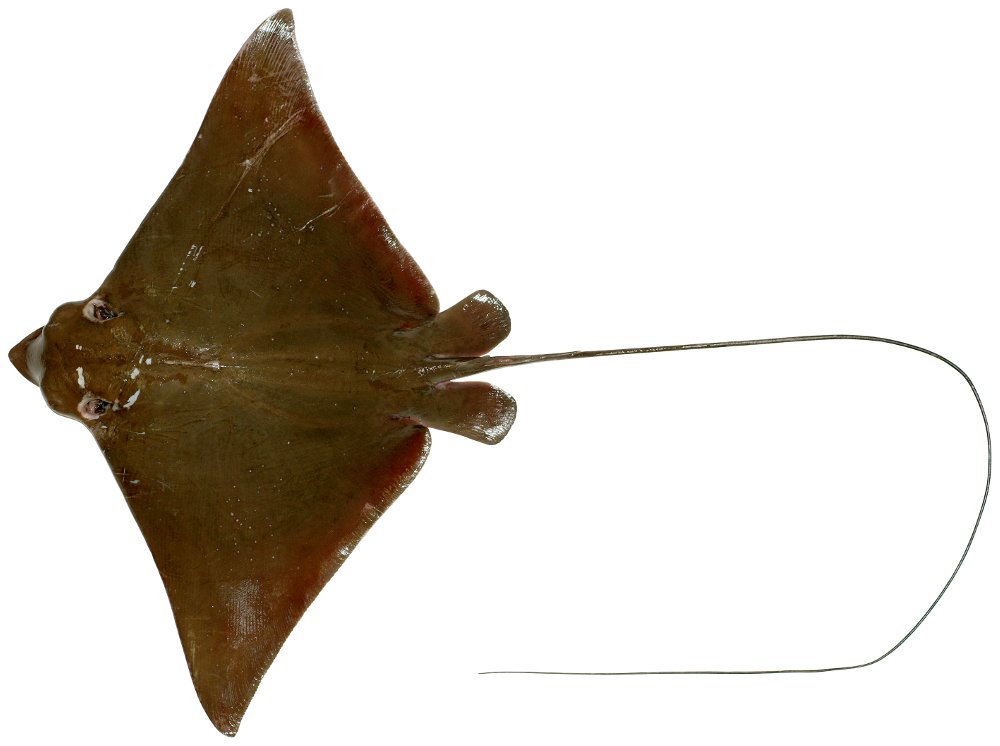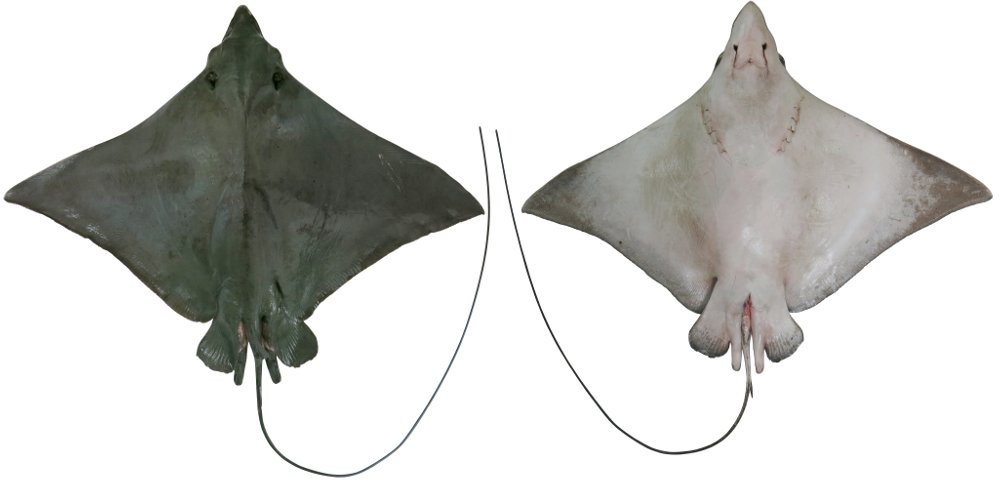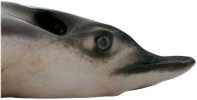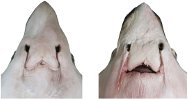Aetobatus narutobiei
White, Furumitsu & Yamaguchi, 2013
Classification: Elasmobranchii Myliobatiformes Aetobatidae
Reference of the original description
A New Species of Eagle Ray Aetobatus narutobiei from the Northwest Pacific: An Example of the Critical Role Taxonomy Plays in Fisheries and Ecological Sciences. PLoS ONE, 8(12), Article e83785
A New Species of Eagle Ray Aetobatus narutobiei from the Northwest Pacific: An Example of the Critical Role Taxonomy Plays in Fisheries and Ecological Sciences. PLoS ONE, 8(12), Article e83785
Image of the original description

Aetobatus narutobiei White, Furumitsu & Yamaguchi, 2013, CSIRO H 7465-01; paratype, juvenile female (516 mm DW). © White WT, Furumitsu K, Yamaguchi A (2013) A New Species of Eagle Ray Aetobatus narutobiei from the Northwest Pacific: An Example of the Critical Role Taxonomy Plays in Fisheries and Ecological Sciences. PLoS ONE 8(12): e83785

Aetobatus narutobiei White, Furumitsu & Yamaguchi, 2013, CSIRO H 7465-01; paratype, juvenile female (516 mm DW). © White WT, Furumitsu K, Yamaguchi A (2013) A New Species of Eagle Ray Aetobatus narutobiei from the Northwest Pacific: An Example of the Critical Role Taxonomy Plays in Fisheries and Ecological Sciences. PLoS ONE 8(12): e83785
Types
Aetobatus narutobiei
Holotype: FFNU: P-2001; Paratype: CSIRO: H 7464-01; CSIRO: H 7465-01; FFNU: P-2006; FFNU: P-2007; FFNU: P-2014; FFNU: P-2005; FFNU: P-2013; FFNU: P-2010; FFNU: P-2011; FFNU: P-2008; FFNU: P-2009; FFNU: P-2012; FFNU: P-2003; FFNU: P-2015; FFNU: P-2002; FFNU: P-2004; NSMT: P 65338;
Aetobatus narutobiei
Holotype: FFNU: P-2001; Paratype: CSIRO: H 7464-01; CSIRO: H 7465-01; FFNU: P-2006; FFNU: P-2007; FFNU: P-2014; FFNU: P-2005; FFNU: P-2013; FFNU: P-2010; FFNU: P-2011; FFNU: P-2008; FFNU: P-2009; FFNU: P-2012; FFNU: P-2003; FFNU: P-2015; FFNU: P-2002; FFNU: P-2004; NSMT: P 65338;
Description :
Citation: Aetobatus narutobiei White, Furumitsu & Yamaguchi, 2013: In: Database of modern sharks, rays and chimaeras, www.shark-references.com, World Wide Web electronic publication, Version 01/2026
Please send your images of "Aetobatus narutobiei" to info@shark-references.com

Aetobatus narutobiei White, Furumitsu & Yamaguchi, 2013, FFNU-P-2001; holotype, adult male (831 mm DW) © White WT, Furumitsu K, Yamaguchi A (2013) A New Species of Eagle Ray Aetobatus narutobiei from the Northwest Pacific: An Example of the Critical Role Taxonomy Plays in Fisheries and Ecological Sciences. PLoS ONE 8(12): e83785

Aetobatus narutobiei White, Furumitsu & Yamaguchi, 2013, FFNU-P-2001; holotype, adult male (831 mm DW) © White WT, Furumitsu K, Yamaguchi A (2013) A New Species of Eagle Ray Aetobatus narutobiei from the Northwest Pacific: An Example of the Critical Role Taxonomy Plays in Fisheries and Ecological Sciences. PLoS ONE 8(12): e83785
Common names
Naru eagle ray
Naru eagle ray
Short Description
Original diagnosis after WHITE, FURUMITSU & YAMAGUCHI, 2013 [20089]: A medium to large-sized Aetobatus (attaining 1500 mm DW) with the following combination of characters: dorsal surfaces uniformly greenish grey to brownish, without pale spots or ocelli; head long (ventral head length 27.4–31.9% DW); rostral lobe long to very long (longest in adult males) and narrow, tapering evenly to tip; teeth plates in a single row, those in lower jaw chevron-shaped; width of lower tooth plate about 2.4 times its width and in about 18 series; pectoral-fin radials 100–104 (excluding propterygial radials anterior of eyes); total vertebral centra (including synarcual) 88–90; pelvic-fin radials 1 (with 2–5 fused elements) +17–18; males mature by about 800 mm DW; born at 334–352 mm DW.
Original diagnosis after WHITE, FURUMITSU & YAMAGUCHI, 2013 [20089]: A medium to large-sized Aetobatus (attaining 1500 mm DW) with the following combination of characters: dorsal surfaces uniformly greenish grey to brownish, without pale spots or ocelli; head long (ventral head length 27.4–31.9% DW); rostral lobe long to very long (longest in adult males) and narrow, tapering evenly to tip; teeth plates in a single row, those in lower jaw chevron-shaped; width of lower tooth plate about 2.4 times its width and in about 18 series; pectoral-fin radials 100–104 (excluding propterygial radials anterior of eyes); total vertebral centra (including synarcual) 88–90; pelvic-fin radials 1 (with 2–5 fused elements) +17–18; males mature by about 800 mm DW; born at 334–352 mm DW.
Distribution
Most records were from the south-western part of Japan. Records of this species from adjacent regions include: Macao, China [11]; Hong Kong [16]; Korea [19], [25]; and Cat Ba Island in Vietnam [29] [20089] Source: www.gbif.org
Most records were from the south-western part of Japan. Records of this species from adjacent regions include: Macao, China [11]; Hong Kong [16]; Korea [19], [25]; and Cat Ba Island in Vietnam [29] [20089] Source: www.gbif.org
Size / Weight / Age
Type specimens ranged from 342 to 1210 mm DW. Juvenile males ranged from 353–455 mm DW; subadult male was 759 mm DW; adult males ranged from 803 to 937 mm DW. Females ranged from 342 to 1210 mm DW. [20089];
Type specimens ranged from 342 to 1210 mm DW. Juvenile males ranged from 353–455 mm DW; subadult male was 759 mm DW; adult males ranged from 803 to 937 mm DW. Females ranged from 342 to 1210 mm DW. [20089];
Dentition
Teeth in a single row in each jaw, coalesced to form plates (Fig. 5); lower jaw tooth plate length about 2.4 times its width, its width 0.79 (0.70–0.87) mouth width; lower jaw teeth narrow, chevron-shaped, in 18 series (based on dissected specimen FFNU-P-2015); upper tooth plate length about 0.9; upper jaw teeth narrow, mostly transverse but curving posteriorly distally, in 13 series (based on dissected specimen FFNU-P-2015) [20089];
Teeth in a single row in each jaw, coalesced to form plates (Fig. 5); lower jaw tooth plate length about 2.4 times its width, its width 0.79 (0.70–0.87) mouth width; lower jaw teeth narrow, chevron-shaped, in 18 series (based on dissected specimen FFNU-P-2015); upper tooth plate length about 0.9; upper jaw teeth narrow, mostly transverse but curving posteriorly distally, in 13 series (based on dissected specimen FFNU-P-2015) [20089];
Remarks
shark-references Species-ID=13830;
shark-references Species-ID=13830;



















